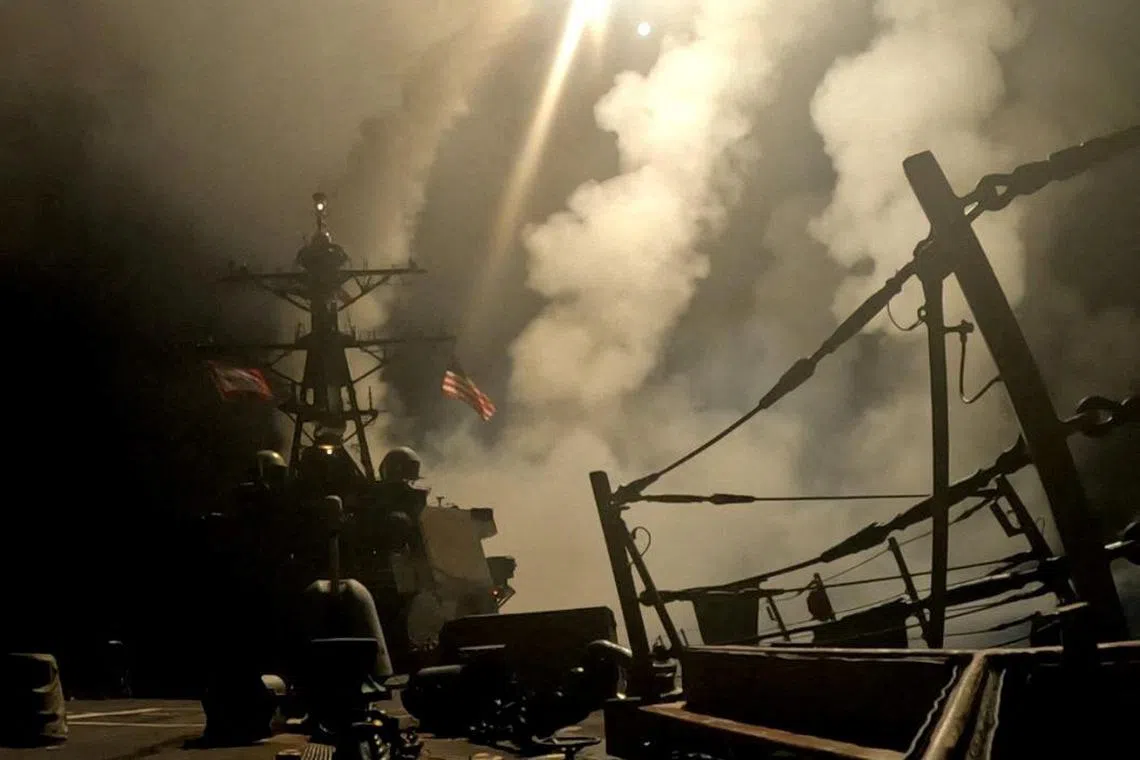News analysis
‘Hell will rain down on you’: Trump, the Houthis and the US’ proxy war with Iran
Sign up now: Get ST's newsletters delivered to your inbox

A ship firing missiles at an undisclosed location, after US President Donald Trump launched military strikes against Yemen's Iran-aligned Houthis.
PHOTO: REUTERS
Follow topic:
LONDON – Yemen’s Houthi authorities have claimed responsibility for drone and missile strikes against the US aircraft carrier Harry S. Truman on March 16, allegedly in retaliation for a wave of deadly US raids across Yemen.
Mr Yahya al-Sarea, the group’s military spokesman, said Houthi ground, air and naval forces fired 18 missiles and conducted a drone strike against the vessel “and its affiliated warships in the northern Red Sea” in response to the US raids.
He added: “This US aggression will only increase the steadfastness, faith and resilience of Yemen and its steadfast, faithful and struggling people.”
But an unnamed senior Pentagon official in Washington briefed the American media that US warships had shot down “a dozen attack drones” and that the US naval strike group led by the USS Harry S. Truman “had been unaffected”.
What remains beyond doubt, however, is the seriousness of the current confrontation between Yemen’s Houthis and the US, which is guaranteed to get more violent.
At stake is not only the international freedom of navigation, which the Houthis are endangering, but the broader looming showdown between the US and Iran, which could well decide security arrangements throughout the Middle East.
Since the start of the Gaza war in October 2023,
The Islamist militia, which controls much of Yemen, disrupted one of the world’s most important commercial sea routes, which passes through the Bab-el-Mandeb strait on Yemen’s coastline and connects Asian and European markets.
The longer route vessels must take to avoid the Bab-el-Mandeb added about two weeks to shipping times and around 35 per cent to international shipping costs. It also resulted in an overall rise in maritime insurance premiums.
The Houthis, whose motto is “Death to America, death to Israel, and a curse on the Jews”, justified their actions as a gesture of solidarity with Hamas, the Palestinian militia in control of Gaza.
For much of 2024, the administration of then President Joe Biden authorised repeated military strikes against the Houthis. But these were usually undertaken only in response to specific Houthi attacks on shipping; as Mr Biden’s officials readily admitted, they were merely seeking to reduce rather than eliminate the Houthi threat.
This threat eased in January 2025, when Israel and Hamas agreed to a ceasefire in the Gaza war,
But after Israel recently refused to extend the ceasefire and blocked aid deliveries to Gaza, the Houthis announced on March 11 that they would resume their firing at passing ships.
The strikes on Yemen ordered by US President Donald Trump
Addressing the Yemen militants directly, Mr Trump wrote on social media that if they did not stop immediately, “hell will rain down upon you like nothing you have ever seen before”.
The American military action is now intensifying. Bombings of Houthi military installations around Sanaa, Yemen’s capital, during the early hours of March 17 were especially heavy.
However, President Trump’s real target is Iran, the country widely regarded as the Houthis’ chief military backer.
Mr Trump urged Iran not to threaten the American people, its president, or the world’s shipping lanes.
“Be warned, because America will hold you accountable, and we will not be nice to you!” the US President wrote on social media.
The Houthi movement owes its existence to Yemen’s domestic problems. Formally known as the Ansar Allah (Partisans of God), the group emerged in the 1990s as a militia to defend the Zaidis, a local Shi’ite Muslim minority.
Iran, the Middle East’s biggest Shi’ite nation, has frequently acknowledged its sympathies with the Houthis, but has always denied that it is supplying the militia with weapons.
“The Houthis are independent and make their own strategic decisions,” claimed Major-General Hossein Salami, the commander-in-chief of Iran’s Islamic Revolutionary Guard Corps (IRGC), in a statement on March 16.
Yet few take such Iranian denials seriously. Apart from their religious affinity, the Houthis pledge allegiance to Iran’s so-called “Axis of Resistance”, which includes other radical groups such as Hamas and the Hezbollah Shi’ite militia in Lebanon.
More significantly, the Houthis are firing Iranian-made missiles, including long-range missiles that have hit Israel and which are often guided to their targets by intelligence-gathering ships operated by Iran’s IRGC.
Iran is, therefore, not merely supplying the weapons; it is also integral to the Houthi operation.
The Trump administration is now seeking to tackle this fundamental problem by forcing Iran to stop its support for the Houthis.
The timing is opportune. Although the war in Gaza is far from over, and Israel has failed to eliminate Hamas, the organisation is severely weakened and is no longer able to act as an Iranian ally.
Hezbollah in Lebanon, Iran’s most valuable regional military proxy, has been equally torn apart by Israel. All the organisation’s senior leaders were killed, most of its arsenal was destroyed, and the militia will need years to regroup if it manages to survive.
President Bashar al-Assad of Syria was also overthrown, thereby removing another key Iranian ally.
In many respects, therefore, the Houthis are now Iran’s only primary functioning proxy.
Both President Trump and Mr J.D. Vance, his deputy, have recently stated that America has no interest in launching a military strike on Iran.
Nevertheless, the Trump administration is determined to knock out Iran’s last regional ally as part of a broader objective of reducing Tehran’s regional influence.
For the moment, the Houthis appear undeterred. Although Yemen is a humanitarian disaster, with an estimated one in two children suffering from malnutrition, the militia seems determined to position itself as a significant regional actor.
And at least for now, its Iranian backers are equally undeterred.
Rejecting US demands to stop supporting the Houthis, Iranian Foreign Minister Abbas Araqchi wrote in a March 16 post on X that the US “has no authority, or business, dictating Iranian foreign policy”.
Chances are high, therefore, that the current showdown will only worsen, for Mr Trump appears determined to win this first military confrontation of his second presidential term.
All this is music to the ears of Israeli Prime Minister Benjamin Netanyahu, who always assumed that sooner rather than later and more by accident than design, the US and Iran would come to direct blows.


